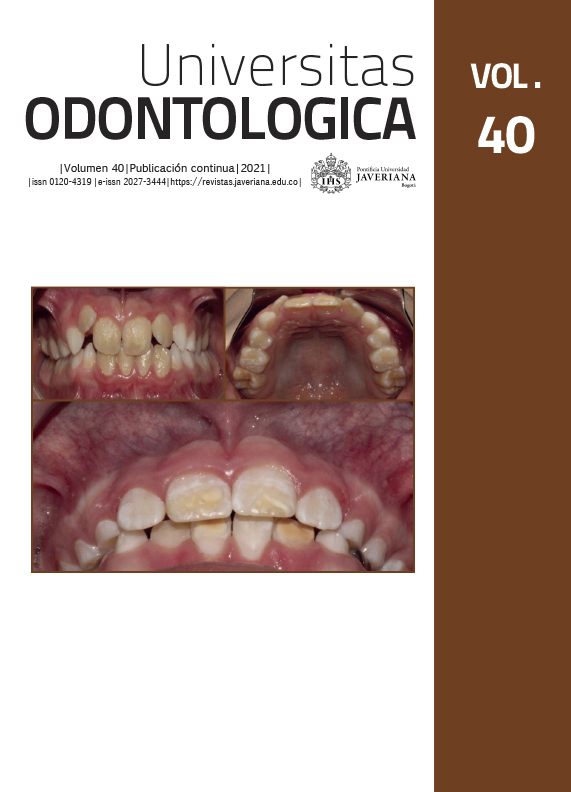Resumo
Antecedentes: Frênulas são estruturas semelhantes a dobras de tecido conjuntivo que são inseridas no osso maxilar superior. Essa estrutura anatômica, que muitas vezes passa despercebida durante o exame oral, apresenta variações de inserção que estão associadas a diastemas, problemas fonéticos, periodontais e ortodônticos. Objetivo: Identificar o tipo de inserção do frênulo labial superior associado à presença de diastemas, em alunos de 8 a 15 anos que frequentam a Unidade Educacional Vicente Anda Aguirre do Cantão de Mocha, Equador. Métodos: Foi realizado um estudo descritivo com desenho observacional transversal, com amostra de 300 crianças de 8 a 15 anos, que atenderam aos critérios de inclusão e exclusão. Foi realizado exame clínico e registro fotográfico do frênulo labial superior para análise das variáveis: tipo de inserção e presença de diastemas em relação à idade e sexo. Por meio do teste Qui-quadrado e regressão linear, avaliou-se a associação entre essas variáveis (p = 0,05). Resultados: 44,67 % apresentaram frênulo do lábio superior com inserção gengival. A inserção papilar penetrante foi encontrada em 27,54 % e esteve mais relacionada à presença de diastema, sendo o tipo leve o que ocorreu com maior frequência (66,67 %) independente do sexo. Conclusões: A idade apresentou estreita relação com o local de inserção do frênulo, sendo sua localização mais coronal em idade precoce. Portanto, pode ser um fator predisponente para o aparecimento de diastemas.
Mirko P, Miroslav S, Lubor M. Significance of the labial frenum attachment in periodontal disease in man. Part 1. Classification and epidemiology of the labial frenum attachment. J Periodontol. 1974 Dec; 45(12): 891-894. https://doi.org/10.1902/jop.1974.45.12.891
Boutsi EA, Tatakis DN. Maxillary labial frenum attachment in children. Int J Paediatr Dent. 2011 Jul; 21(4): 284-288. https://doi.org/10.1111/j.1365-263X.2011.01121.x
Oquendo A, Brea L, David S. Diastema: correction of excessive spaces in the esthetic zone. Dent Clin North Am. 2011 Apr; 55(2): 265-281. https://doi.org/10.1016/j.cden.2011.02.002
Devishree, Gujjari SK, Shubhashini PV. Frenectomy: a review with the reports of surgical techniques. J Clin Diagn Res. 2012 Nov; 6(9): 1587-1592. https://doi.org/10.7860/JCDR/2012/4089.2572
Upadhyay S, Ghimire N. Attachment of maxillary labial frenum in Nepalese children. Orthod J Nepal. 2013 Jun; 2(1): 38-31. https://doi.org/10.3126/ojn.v2i1.9291
Delli K, Livas C, Sculean A, Katsaros C, Bornstein MM. Facts and myths regarding the maxillary midline frenum and its treatment: A systematic review of the literature. Quintessence Int. 2013 Feb; 44(2): 177-187. https://doi.org/10.3290/j.qi.a28925
Abrahams R, Kamath G. Midline diastema and its aetiology—a review. Dent Update. 2014 Jun; 41(5): 457-464. https://doi.org/10.12968/denu.2014.41.5.457
Mohan R, Soni P, Gundappa M, Krishna M. Proposed classification of medial maxillary labial frenum based on morphology. Dent Hypotheses. 2014 Mar; 5(1): 2-6. https://doi.org/10.4103/2155-8213.128108
Suter VGA, Heinzmann A-E, Grossen J, Sculean A, Bornstein MM. Does the maxillary midline diastema close after frenectomy? Quintessence Int. 2014 Ene; 45(1): 57-66. https://doi.org/10.3290/j.qi.a30772
Díaz A, Puerta MA, Verbel J. Manejo quirúrgico de frenillos labiales sobreinsertados: reporte de caso. Rev Salud Bosque. 2015 Ago; 4(1): 69-74. https://doi.org/10.18270/rsb.v4i1.33
Castro-Rodríguez Y, Grados-Pomarino S. Relación entre frenillos labiales y periodonto en una población peruana. Rev Clin Periodon Implantol Rehabil Oral. 2016 Oct; 6(2): 24-34. http://dx.doi.org/10.1016/j.piro.2016.09.006
Guerrero BE. Revisión para el manejo del frenillo Labial. Rev Med Basadrina. 2016 Oct; 10(2): 52-57. https://doi.org/10.33326/26176068.2016.2.606
Jindal V, Kaur R, Goel A, Mahajan A, Mahajan N, Mahajan A. Variations in the frenal morphology in the diverse population: A clinical study. J Indian Soc Periodontol. 2016 Jul; 20(3): 320-323. https://doi.org/10.4103/0972-124X.182598
Sękowska A, Chałas R. Diastema size and type of upper lip midline frenulum attachment. Folia Morphol (Warsz). 2016 Oct; 76(3): 501-505. https://doi.org/10.5603/FM.a2016.0079
Santa Maria C, Aby J, Truong MT, Thakur Y, Rea S, Messner A. The superior labial frenulum in newborns: What is normal? Glob Pediatr Health. 2017 Jul; 10(4): 1-6. https://doi.org/10.1177/2333794X17718896
Castro-Rodríguez Y. Tratamiento del frenillo aberrante, frenectomía y frenotomía. Revisión de tema. Rev Nac Odontol. 2017; 14(26): 1-10.
Dasgupta P, Kamath G, Hs S, Babshet M, Doddamani L. Morphological variations of median maxillary labial frenum: A clinical study. J Stomatol Oral Maxillofac Surg. 2017 Dec; 118(6): 337-341. https://doi.org/10.1016/j.jormas.2017.06.018
Jonathan PT, Thakur H, Galhotra A, Galhotra V, Gupta N. Maxillary labial frenum morphology and midline diastema among 3 to 12-year-old schoolgoing children in Sri Ganganagar city: A cross-sectional study. J Indian Soc Pedod Prev Dent. 2018 Sep; 36(3): 234-239. https://doi.org/10.4103/JISPPD.JISPPD_51_18
Prasad KN, Sabrish S, Mathew S, Shivamurthy PG, Pattabiraman V, Sagarkar R. Comparison of the influence of dental and facial aesthetics in determining overall attractiveness. Int Orthod. 2018 Dec; 16(4): 684-697. https://doi.org/10.1016/j.ortho.2018.09.013
Encalada Verdugo L, Garcia-Rupaya CR, Del Castillo López CE. Calidad de vida relacionada a la salud oral en escolares del sector urbano y rural. Cañar, Ecuador. Rev Estomatol. Herediana. 2018 Jul; 28(2): 105-114. https://doi.org/10.20453/reh.v28i2.3326

Este trabalho está licenciado sob uma licença Creative Commons Attribution 4.0 International License.
Copyright (c) 2021 Christian Paul Ocaña Caluña, Sandra Magdalena Macías Ceballos


